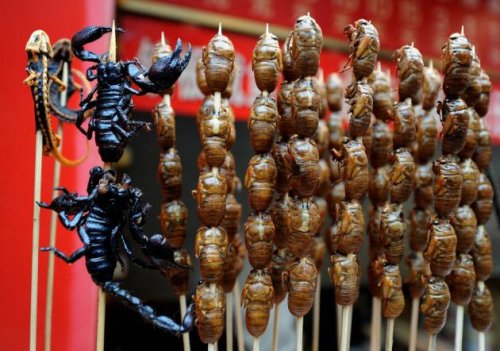Laos Holds Finger-Lickin’ Taste Of Our Future
The UN Food and Agriculture Organisation (FAO) has cooked up a possible solution to the global food crisis by encouraging people to eat more insects.
The FAO discusses the menu and other arrangements in a research report titled “Edible Insects: Future Prospects for Food and Feed Security”.
Flicking through the report will bring few surprises for Laotians who, along with people elsewhere in Asia, have been eating insects for as long as anyone can remember – either as snacks or as full-blown meals.
But the FAO has also confirmed that bugs are highly nutritious, rich in protein, vitamins, fibre and minerals.
Among the healthier snacks consumed in Laos are a wide variety of grubs and bugs, usually fried in oil. And the harvest is especially bountiful at this time of the year, as we head into the wet season. The average Laotian knows exactly what can be eaten and what cannot, and at what time of year what particular insect Mother Nature will serve up in abundance – and on what sort of plant it likes to feed.
At this time of the year some of the most popular additions to the menu include maeng kha noon (leaf-eating beetle), maeng mao (moth), maeng kheng (stinkbug), grasshopper and crickets.
Leaf beetles usually appear in early April, when they fatten up on the new growth springing up in the forests after the first and second rains of the year. They especially like to eat the young leaves of Pterocarpus indicus, khom, jujube and tamarind trees.
Sathit, 14, who lives in Hadxaifong district, Vientiane, usually goes out to catch leaf beetles with his younger brother every evening after dinner. They return around an hour later with enough beetles to fry up a pan-full, which makes a satisfying breakfast the next day before they leave for school.
The beetles only appear in April, when the leaves of the trees they feed on are young and tender.
Sathit collects at least four different kinds of leaf beetles. There are small, medium and large ones, and ones with brown or green wings.
Hunting them is not difficult. At midday, Sathit usually checks the trees around his house for the tell-tale sign of torn leaves. This indicates that a tree harbours a colony of beetles, which he will return to collect in the evening.
Sathit has his system all worked out. The beetles make their home high up in the trees, but they don’t escape his long reach. In the dark, he uses a torch to locate the insects, then pushes a stick with a plastic bag attached to the end high up into the branches.
For colonies of insects that are too high even for his stick, he climbs up the tree and shakes the branches while his brother holds the torch below. These beetles will then fly to the light of the torch and fall to the ground, where they are grabbed and trapped in a bucket of water.
Take a trip to the provinces of Laos or northern Thailand and you’ll see vendors grilling leaf beetles on sticks to sell to waiting passengers at bus stations.
Thongdee sells 10 leaf beetles and 10 stinkbugs for 5,000 kip (Bt20) at Ban Lak bus station in Savannakhet province. She uses the same method as Sathit to catch them and averages 100,000 kip a day from her beetle brochettes.
An official from the Ministry of Health says locals know better than doctors what insects they can or cannot eat, because they have learnt about them from their parents. But he cautions “The processing of insects should follow the same health and sanitation regulations as any other traditional food, to ensure food safety.”
Source: Vientiane Times / The Nation

